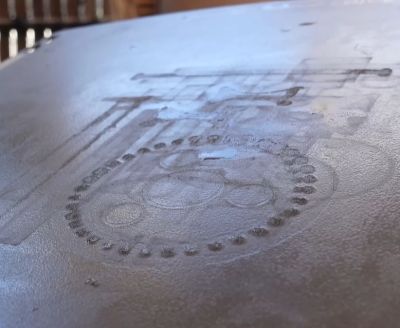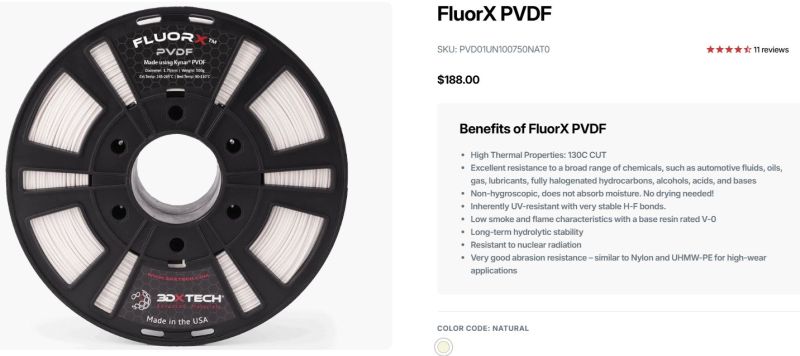There’s a dizzying number of specialist 3D printing materials out there, some of which do try to offer an alternative to PLA, PA6, ABS, etc., while others are happy to stay in their own niche. Polyvinylidene fluoride (PVDF) is one of these materials, with the [My Tech Fun] YouTube channel recently getting sent a spool of PVDF for testing, which retails for a cool $188.

Reading the specifications and datasheet for the filament over at the manufacturer’s website it’s pretty clear what the selling points are for this material are. For the chemists in the audience the addition of fluoride is probably a dead giveaway, as fluoride bonds in a material tend to be very stable. Hence PVDF ((C2H2F2)n) sees use in applications where strong resistance to aggressive chemicals as well as hydrolysis are a requirement, not to mention no hygroscopic inclinations, somewhat like PTFE and kin.
In the video’s mechanical testing it was therefore unsurprising that other than abrasion resistance it’s overall worse and more brittle than PA6 (nylon). It was also found that printing this material with two different FDM printers with the required bed temperature of 110°C was somewhat rough, with some warping and a wrecked engineering build plate in the Bambu Lab printer due to what appears to be an interaction with the usual glue stick material. Once you get the print settings dialed in it’s not too complicated, but it’s definitely not a filament for casual use.
















Could you use it to 3D print a beehive that doesn’t leech turpentine into honey?
If you prefer fluoride based forever chemicals, yes. Hurry up before it is banned.
If honey contains fluoride compounds then it’s actually good for your teeth. Chlorinated plastics on the other hand are VERY nasty.
Organic fluorides aren’t at all healthy for life. The tooth strengthening fluorides are inorganic fluoride salts.
Same goes for PVC fumes being far different than chloride salts essential for life.
PVDF does not cause harm, on the contrary, it is usually used as a water purifier filter material
Chemist here…
Microplastics and forever chemicals in one convenient (albeit expensive) package for the homegamer?
This does look like it would have interesting properties, but I’ll not be printing this in my basement setup!
Oh, don’t worry, I’m sure whoever uses that will be limiting it to genuinely good long term use and not to print next day landfill garbage to get some likes on Instagram or Youtube.
If your sarcasm-o-meter goes wild, it’s working fine.
Not a chemist here*, I think you should take another look at the chemistry because you’ll find that these compounds specifically don’t break down into PFAS. If you’re assessing risk, the big one should be what gasses these give off if printed too hot.
*as in, it’s only a small part of my wider qualifications
PFAS is still commonly used to help in the production of fluoropolymers. The biggest hazard however is the manufacturers of these polymers improperly disposing of waste PFAS.
It might technically work, but I’m not sure that you want little bits of PVDF in your honey either.
It’s not one of the “bad” fluorine-based plastics – although it’s made from PFAS monomers, it’s not itself a PFAS, and it’s used for water filtration membranes and such – but regardless, there are probably better, cheaper options. You don’t need the extreme chemical resistance and thermal stability of PVDF just to build a beehive.
How “pure” are the plastics in these filaments?
A filament may be ASA for example, but what is added to it to give it consistent and stable colour, to help it stick to itself, to flow through nozzles without sticking and to improve its behaviour around its melting point?
A good question, but frustratingly hard to answer. As far as I know manufacturers aren’t required to disclose specifics.
Some filament manufacturers explicitly state that they’re not using any additives or modifiers on certain filaments, but you still have to trust them (and their plastic supplier)… or have some kind of independent testing done by a third-party lab, I guess.
You can get an SDS from the manufacturer for most filaments, but they’re allowed to use generic terms like “PLA Resin” at 100%, and then produce one SDS sheet for their entire line (which obviously includes different colorants and who knows what else)
With pigments at least you can do your homework and find the natural color of the plastic.
Alternatively black is almost always done with carbon black.
Which is known to require very little colorant and provide some UV protection.
Grey maybe stronger out right of the machine, but black will be stronger in 3 months.
It’s not like it’s difficult to analyze plastic, just expensive.
I suspect any brand of plastic that has it’s own slicer profile…
Why would it be different if it wasn’t different?
From mfr site – “base resin rated V-0 ”
Misleading. The end-use material has no rating per UL 94. To get anywhere close to a (marginal) ‘HB’ rating would most likely require 3 to 5mm thickness.
So because it is not an end use product the UL ratings are void, unless perhaps processed in strict accordance with manufacturer specifications?
It’s not very chemical resistant if it interacts with something as simple as a glue stick.
Maybe the high temperature was causing the glue stick to interact with the bed material?
Relative permittivity is 10, compared to most plastics about 3, and it is ferroelectric. . .